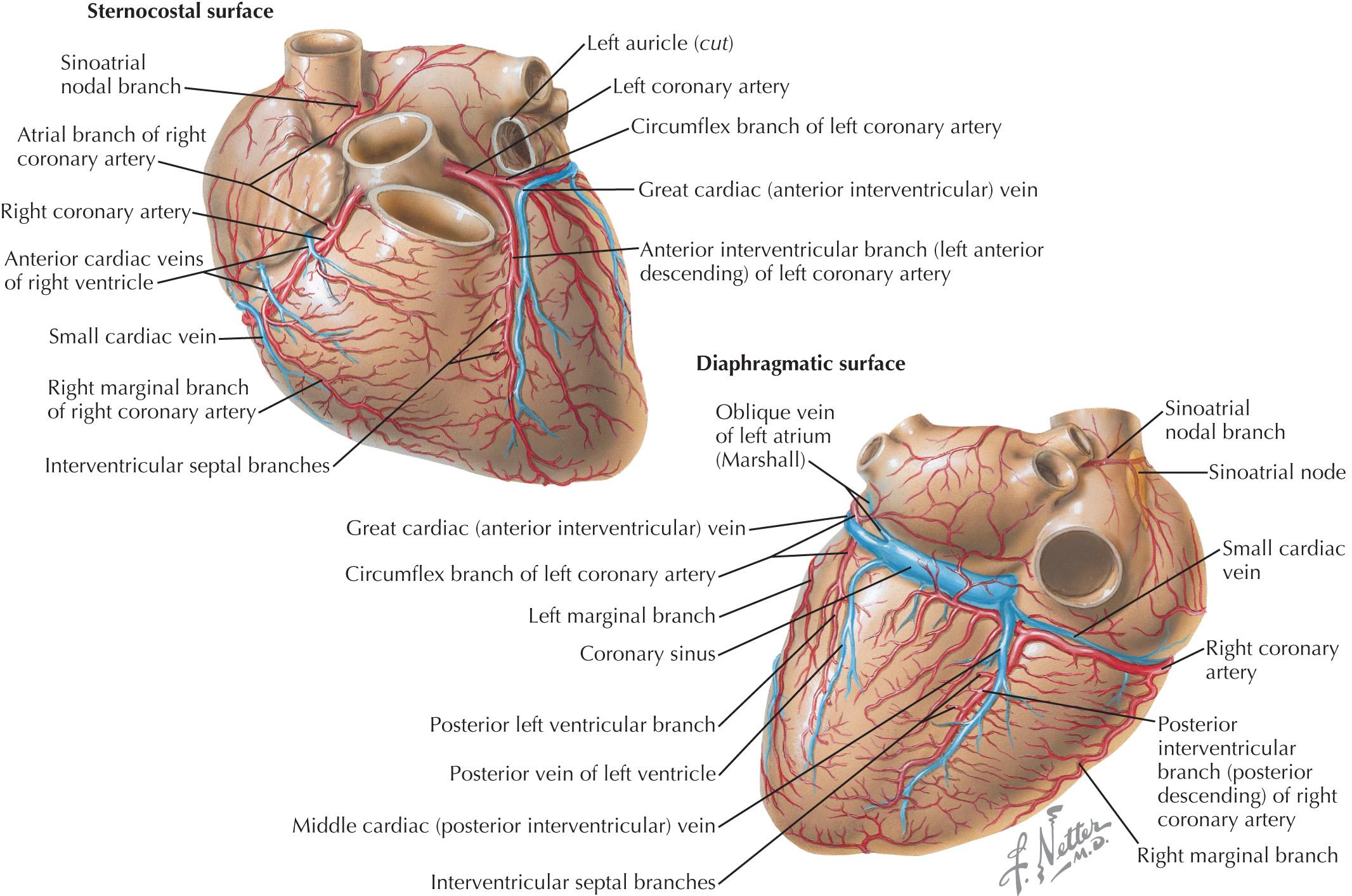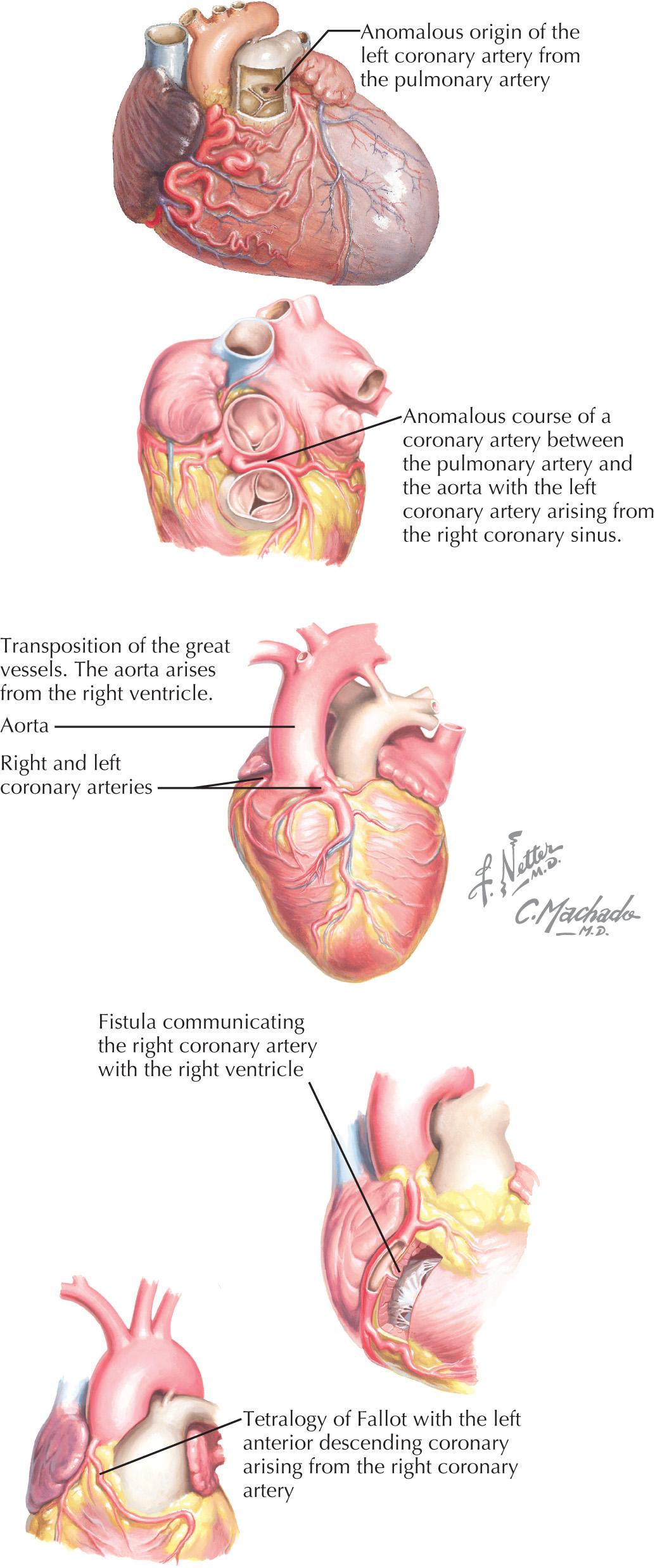Physical Address
304 North Cardinal St.
Dorchester Center, MA 02124
The ability to directly visualize arteries with an injection of a radiopaque contrast agent was a seminal advance in the history of modern medicine and led directly to the development of the concept of transluminal angioplasty (first performed in 1964), coronary artery bypass grafting (CABG; first performed in 1967), percutaneous transluminal peripheral balloon angioplasty (first performed in 1974), and percutaneous coronary intervention (PCI; first performed in 1977). Coronary angiography enables direct visualization of the coronary arteries and provides essential information in the diagnosis and management of coronary artery disease (CAD) by defining the presence, location, and severity of coronary artery pathology. In addition, coronary angiography can be used to diagnose anomalous coronary arteries, spasm, myocardial bridging, fistulas, dissections, and aneurysms. This chapter focuses on coronary anatomy, preprocedural evaluation, technical aspects, and potential complications of diagnostic coronary angiography.
The right coronary artery (RCA) arises from the right coronary sinus and runs in the right atrioventricular (AV) groove ( Fig. 12.1 ). The conus artery is typically the first branch that arises from the RCA and supplies the right ventricular outflow tract. The sinoatrial nodal and AV nodal branches also arise from the RCA and supply the sinus node and the AV node, respectively. Marginal branches usually arise from the mid-RCA and supply the right ventricular wall. The distal RCA gives rise to right posterolateral branches and the posterior descending artery (PDA) in 85% of cases (defined as right dominance). The PDA arises from the left circumflex (LCX) in 8% of cases (defined as left dominance), and from both the RCA and LCX in 7% of cases (defined as co-dominance). The PDA runs in the posterior interventricular groove and supplies the posterior aspect of the interventricular septum.

The left main coronary artery arises from the left coronary sinus and bifurcates into the left anterior descending (LAD) and LCX arteries ( Fig. 12.1 ). In a minority of cases, the left main coronary artery trifurcates into the LAD artery, ramus intermedius artery, and LCX artery. The LAD artery runs in the anterior interventricular groove toward the apex of the heart and supplies the anterior wall of the left ventricle. Septal perforator branches arise from the LAD artery and supply the interventricular septum. Diagonal branches also arise from the LAD artery and supply the anterolateral wall of the left ventricle. The LCX artery runs in the left AV groove and provides obtuse marginal branches that supply the posterolateral wall of the left ventricle. As noted previously, in a minority of cases, the PDA will arise from the LCX artery.
There are many schemes for describing coronary anatomy: the Coronary Artery Surgery Study (CASS) classification, the Synergy Between PCI With Taxus and Cardiac Surgery (SYNTAX) classification, and the Bypass Angioplasty Revascularization Investigation (BARI) modification of the CASS map are some of the most widely accepted.
Coronary artery anomalies are typically a result of abnormal embryological development and are found in 1% to 1.5% of cases. Most coronary artery anomalies are clinically benign. The most common coronary artery anomaly is the presence of separate origins of the LAD and LCX arteries, which occurs in 0.4% to 1% of cases and may be associated with a bicuspid aortic valve. Clinically significant anomalies include a coronary artery originating from the opposite coronary sinus (e.g., left main coronary artery originating from the right coronary sinus), the presence of a single coronary ostium leading to a single coronary artery, a coronary artery coursing between the great vessels (e.g., between the aorta and pulmonary artery), and a coronary artery leading to decreased oxygenation of the myocardium (e.g., a coronary artery originating from the pulmonary artery or a coronary artery–ventricular fistula) ( Fig. 12.2 ).

Obtaining a history, physical examination, routine laboratory data (such as chemistry, complete blood count, and coagulation studies), a 12-lead ECG, and a transthoracic echocardiogram can provide valuable information for procedural planning. An accurate history can help determine patient candidacy for PCI and dual antiplatelet therapy in the event that the angiographic findings demonstrate obstructive CAD. Physical examination of the peripheral pulses can help plan the site of vascular access. Stress testing can be performed to risk stratify patients before coronary angiography and to help localize the area of myocardial ischemia.
The American College of Cardiology and American Heart Association have published guidelines on the indications for diagnostic coronary angiography ( Table 12.1 ). Patients with acute coronary syndromes should undergo emergent or urgent diagnostic coronary angiography. In particular, patients with ST-elevation myocardial infarction (STEMI) should undergo emergent coronary angiography with the goal of establishing reperfusion with angioplasty within 90 minutes of clinical presentation. Patients who have a non-STEMI or unstable angina, and who are at intermediate or high risk for adverse events should undergo early coronary angiography within 24 to 72 hours. Patients with high-risk features (e.g., refractory angina, hemodynamic or electrical instability, or cardiogenic shock) should undergo coronary angiography within the first few hours of clinical presentation.
| Evaluation of Patients With Stable Ischemic Heart Disease (Suspected or Known) |
|
| Evaluation of Patients With Non–ST-Elevation Acute Coronary Syndromes |
|
| Evaluation of Patients With STEMI |
|
| Evaluation of Patients With Heart Failure |
|
| Evaluation of Patients With Valvular Heart Disease |
|
| Evaluation of Patients With Nonvalvular Structural Heart Disease |
|
| Evaluation of Patients Before Noncardiac Surgery |
|
Patients with stable angina and certain clinical features may undergo coronary angiography without previous stress testing. For instance, patients who have symptoms highly typical of angina or patients who have symptoms with minimal or no exertion should be directly referred for coronary angiography without previous stress testing. Additional clinical features that may prompt referral for coronary angiography without previous stress testing include a history of myocardial infarction, previous percutaneous or surgical revascularization, and congestive heart failure.
Become a Clinical Tree membership for Full access and enjoy Unlimited articles
If you are a member. Log in here